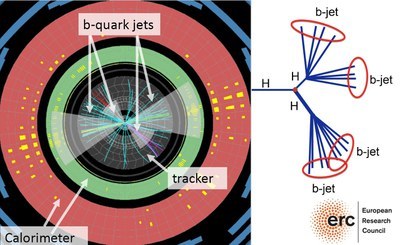ATLAS
The group is part of the international ATLAS collaboration at the Large Hadron Collider (LHC) at CERN.
The primary purpose of the experiments at the Large Hadron Collider at CERN is the discovery of physics beyond our current understanding of nature and the measurements of the properties of the Standard Model particles, including the newly discovered Higgs boson.
One of the most prominent signatures at the LHC to do these studies are final states with hadrons which produce complex particle showers initiated by them and by interactions with the detector material. These particle showers are reconstructed in the detectors as so called “jets”.

Origin of Mass - Higgs Pair Production at the LHC
The group will be working on searches for new physics in di-Higgs final states where at least one of the Higgs bosons decays into a b-quark pair. It will actively work on the calibration and performance studies of jets and b-quark jets in the ATLAS detector. We will work on developing b-quark triggers with very low trigger thresholds and exploit novel algorithms to reconstruct final state particles and perform large scale data analysis. In this context we are also exploring the possibility to use quantum computing algorithms for the reconstruction and identification of Higgs bosons that decay into b-quark pairs.
In addition to searching for new physics beyond the Standard Model, the groups' long term goal is to measure the Higgs self-coupling at the LHC using di-Higgs final states. The Higgs self-coupling is an important parameter and its value influences the shape of the Higgs potential that is important for the mass generation in nature. This research area of the EHEP group is supported by an ERC grant from the Horizon 2020 program.
LHC Forward Cross Section Measurements and Cosmic air shower physics
Strong interactions in a regime of low momentum transfer (so-called soft interactions) cannot be treated perturbatively, which makes the modelling of such processes strongly dependent on experimental input from hadron colliders. In hadron-hadron collisions, e.g. at the LHC, such soft hadronic interactions manifest themselves by the creation of particles in the very forward regions (which means at large rapidities).
These can be measured either by calorimeters in the ultra-forward region of ATLAS, ZDC, or the LHCf detector which can detect neutral particles or by tracking devices located close to the beam like ATLAS AFP and ALFA detectors, which are used for the detection of scattered protons. The measured particle spectra and cross sections will help to tune the currently available phenomenological models for soft hadronic interactions. The improved accuracy of such models would benefit the simulation of air showers induced by cosmic particles as well as the understanding of strong interaction background in proton-proton collisions at the LHC (so-called pile-up). Part of the group is working on the preparations of such measurements with the aforementioned detectors for Run 3 at the LHC for proton-proton collisions as well as for the foreseen proton-Oxygen collisions. Furthermore, we are cooperating with the DESY Zeuthen gamma ray group to exploit synergies in that topic.
